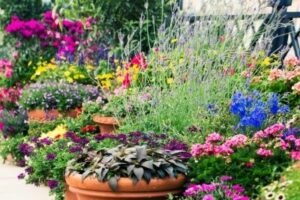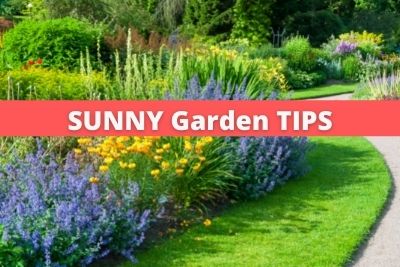Landscapes bathed in sunlight are ideal for colorful gardens, but there are important choices to make so that your plants and shrubs will thrive, depending on just how much sun is directly hitting the space.
“Full sun” gardens are defined as getting at least six hours of direct sunlight every day.
There are a number of full sun species that will burst into bloom in dawn-to-dusk sunlight, while others need a break from intense light, and still more varieties don’t do well in the heat. Your local independent landscape expert can help you choose the right plant in the right spot for your garden, but here are some things to think about when planning your sunlit garden:
The first thing to do is determine exactly how much sunlight is directly hitting the open area you want to turn into a garden. It may seem obvious to keep track of the sunshine, but some people simply guess. Or they generalize a plot of land and consider it as a single space.
 Instead, look at that plot as a group of sections and take a few days to watch the sun and note exactly how long the light hits each section. Remember, full sun is anything over six hours. “Partial sun” gardens are defined by 3-6 hours of daily sunshine. Even if there are breaks in the sunshine, you want to record the total for the day. Also note the intensity of morning sunshine vs. the hot midday sun. It will make a difference when deciding what to plant where. Notice the sections that tend to stay in the shade longer. You get the idea.
Instead, look at that plot as a group of sections and take a few days to watch the sun and note exactly how long the light hits each section. Remember, full sun is anything over six hours. “Partial sun” gardens are defined by 3-6 hours of daily sunshine. Even if there are breaks in the sunshine, you want to record the total for the day. Also note the intensity of morning sunshine vs. the hot midday sun. It will make a difference when deciding what to plant where. Notice the sections that tend to stay in the shade longer. You get the idea.
Now that you have knowledge on the amount of sunlight, you are in a good position to choose a mix of annuals and perennials that will thrive in the space.
Annuals such as Marigolds and Petunias burst with color. Flowers such as zinnias won’t wither in the heat and will hold up even in dry conditions. Berry shrubs (strawberry, blueberry) are at peak performance when they get full sun. There are many low maintenance annuals to choose from to add color and variety to your space.
The goal is to keep your vibrant colors and textures going strong from spring through fall. A good selection of perennials will do the trick. Iris and peonies bloom early in the season, flowers such as daylilies and yarrow come later in the summer.
Master gardener Anita Tilley of Williamson County, Tennessee, took us on a tour of her garden. Not only does she offer many examples of the variety of plant choices, she also has well-defined sections of her yard: the shady section, a vegetable garden, and one devoted to full sun perennial beds.
“This particular bed gets probably 8-10 hours of morning and afternoon sun,” Anita says while standing in her full sun garden. “This bed is really all about my honeybees in terms of having various plants that are of a benefit to them. So, I’ve got Echinacea, Tennessee coneflower here. And behind it is black-eyed Susan, which doesn’t bloom until the August timeframe, so it provides a great nutrition source for bees later in the year.”
Coneflowers and black-eyed Susans are excellent choices for the section of Anita’s garden that gets an abundant of daily sunlight. She also planted different varieties of salvias to feed the bees earlier in the season.
“I’ve deadheaded the salvias to have them come back to give me another awesome source for the bees,” Anita says, noting that the salvia also “provides a great filler as a cutting flower.”
Keep in mind that plants that do well in one part of the year, may not thrive later as seasons change. And for aesthetic reasons, don’t be afraid to lift and move plants from one section to another.
“We’ve got yarrow in the back here with their pretty little yellow flowers. At some point this fall I’m probably going to move that forward because that poor little guy is just a little bit short back there.”
“That’s an example…right plant, right place,. You get something in there because you think it was the right place at the time and you find that, hey, I’ve got to rearrange some things.”
[Yard not getting enough sunlight? Click here to read our story on tips for growing a shady garden.]
Before you choose the right plant in the right place, use this guide to determine the landscape you are working with:
- Full sun plants need at least six hours of direct sunlight every day
- Partial sun plants require 3-6 hours
- Partial shade plants will thrive with up to six hours of direct sunlight per day, as long as they are out of intense midday sun
- Full shade plants do well with less than three hours of direct sunlight per day
An abundance of natural light is a gift that will turn your open space into the eye-popping garden you envision. No matter how much sun you get, there’s a plant and shrub for you.
And if you need expert advice, your local independent landscaper can give you tips and options to make this year’s garden the best yet.

